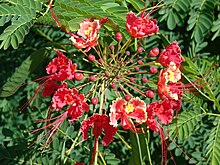Caesalpinia
| Caesalpinia | |
|---|---|
 |
|
| Caesalpinia pulcherrima | |
| Scientific classification | |
| Kingdom: | Plantae |
| (unranked): | Angiosperms |
| (unranked): | Eudicots |
| (unranked): | Rosids |
| Order: | Fabales |
| Family: | Fabaceae |
| Subfamily: | Caesalpinioideae |
| Tribe: | Caesalpinieae |
| Genus: |
Caesalpinia L. |
| Type species | |
|
Caesalpinia brasiliensis L. |
|
| Species | |
|
See text. |
|
| Synonyms | |
|
|
See text.
Caesalpinia is a genus of flowering plants in the legume family, Fabaceae. Membership within the genus is controversial, with different publications including anywhere from 70 to 165 species, depending largely on the inclusion or exclusion of species alternately listed under genera such as Hoffmannseggia. It contains tropical or subtropical woody plants including lianas. The generic name honors the botanist, physician and philosopher Andrea Cesalpino (1519-1603).
The name Caesalpinaceae at family level, or Caesalpinioideae at the level of subfamily, is based on this generic name.
A number of Caesalpinia liana species, including C. mimosoides and C. sumatrana are called "cat's claws": recognisable by raised spines on the stems (illustrated) and found in tropical forests of south-east Asia.
Some species are grown for their ornamental flowers. Brazilwood (C. echinata) is the source of a historically important dye called brazilin and of the wood for violin bows. Guayacaú Negro (C. paraguariensis) is used for timber in several Latin American countries, especially Argentina and Paraguay. Commercially it is marketed as Argentinian Brown Ebony, mistakenly as Brazilian Ebony, and as a family group as Partridgewood. End use for this timber is typically high-end exotic hardwood flooring, cabinetry and turnings.
...
Wikipedia
